Vintage / Antique Gold Gilded Shelley English Bone China Henley Shape Platter
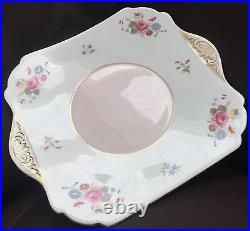
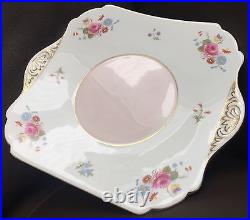
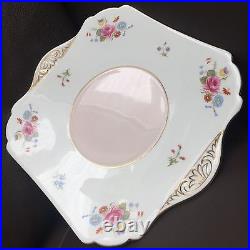

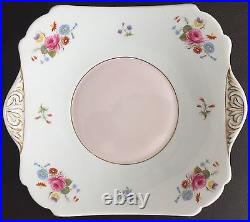





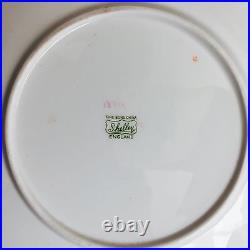


Vintage / Antique (1940s) Gold Gilded Shelley English Bone China "Henley" Shape "Rose and Red Daisy" Platter. The shape is similar to the original "Dainty" shape was created by Roland Morris. The renown Frederick Rhead worked at Shelley as art director and some of the most beautiful pieces of art pottery became symbols of the company in the Art Deco period.
This platter is one of the earlier Shelly products in existence. A marvellous collector's item of the highest order. In excellent condition despite its age and free from any cracks or crazing.
Please study all 12 photos attached. There is a number 13714 just above the back-stamp of the plate. Pattern 13714's decor or the decoration found on this plate is called "Rose and Red Daisy" Wileman/Late Foley/Shelley created more than 140 shapes. The back stamps is the last one Shelley used, from 1940 to 1966, the year the company was taken over by Allied Potteries. Pattern 13714 was probably entered in the pattern book in the late 40's.
Reference: Chris Davenport, author of "Shelley Pottery - The Later Years", page 91; Sheryl Burdess, author of "Shelley Tea Ware Patterns", page 215. I'm told the back-stamp and the design itself dates this Shelley piece to the late 1940s. The Shelley story begins about 1860 when the Wileman family, owners of the Foley works, a large pottery between Longton and Fenton in Staffordshire, England, built a second pottery for the purpose of producing fine china. Two years later Joseph B.
Shelley, left his position at the Dresden works and joined Henry Wileman and his sons as a mere traveler or salesperson. In 1864, Henry Wileman died and his two sons Charles and James split the two works with James running the earthenware works and Charles the china works. In 1870 Charles retired, and James took over both enterprises. He made Joseph Shelley his partner and the firm became known as Wileman & Company. Shelley focused on getting the best china product possible out of the company and staff.He worked on improving china quality and building the foreign export part of the business. Joseph Shelley took his son Percy into the firm in 1881. Percy was to run the company for some 50 years. Percy learned the business fast and set off to find top pottery artists and litho designers to improve the appearance and quality of the wares.
In 1896, attention was directed to English and foreign sales and after the death of Joseph, Percy Shelley was in full control. The popular Dainty shape was created by one of those artists named Rowland Morris. The renowned Frederick Rhead came to work as art director and some of the most beautiful pieces of art pottery became symbols of the company. About 1910, Shelley became involved in a legal battle with other potteries about the use of the name "Foley" (the pottery region).
Shelley lost the battle and decided to rename his pottery "Shelley" which became official in 1925 and our love affair with this name was solidified. More famous artists were employed such as Walter Slater and his son Eric, and Hilda Cowham and Mabel Lucie Attwell for children's ware. The Shelley Style probably reached its peak with the art deco styles produced in the 1920s-1930s. At the same time advertising expenses were at their peak as well.
In 1932, Percy Shelley retired and his sons Percy Norman, Vincent Bob, and Kenneth Jack took over. By the beginning of World War II the pottery side of Shelley's was closed forever. During the war the Board of Trade required that production of English domestic china be significantly cut back, but Shelleys could still produce due to its strong export business, which was permitted to continue. Late in the war, Shelleys began producing its best bone china for export, and its reputation abroad continued to rise. In the 1950s great quantities of bone china in countless patterns were exported and domestic production began to grow again after wartime restrictions were lifted.
The peak of activity was sometime during the 1950s. But by the late 1950s the pottery industry was modernizing and producing larger volumes at cheaper prices by consolidating small firms into larger ones.
Shelley's more expensive bone china lost market share, and catching up to the conglomerates was next to impossible. Some production of Shelley labeled china continued for a time until stocks were exhausted. All of the Shelley facilities are now gone. Only its history and its unmatched products carry on to this day. This item is in the category "Pottery, Ceramics & Glass\Decorative Cookware & Tableware\Tea & Coffee Pots". The seller is "santoor-uk" and is located in this country: GB. This item can be shipped worldwide.- Material: Porcelain/ China
- Product Type: Serving Dish
- Date: 1940s
- Brand: Shelley
- Use: Tableware
- Boxed/ Unboxed: Unboxed
- MPN: 13714
- Sub-Type: British
- Colour: White
- Original/Reproduction: Antique Original
- Style: Henley Shape
- Year Manufactured: 1940s
- Type: Platter
- Date Range: 1940-1959
